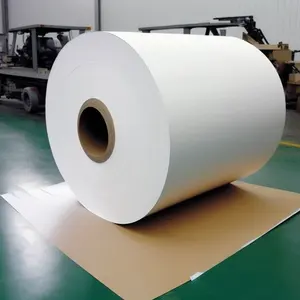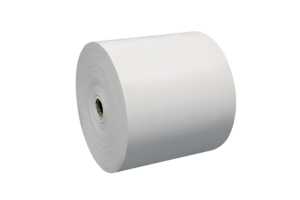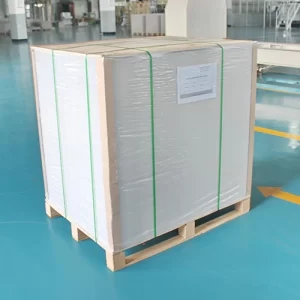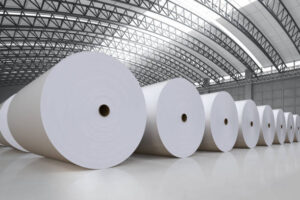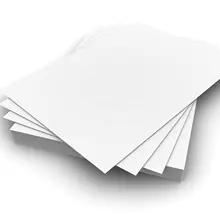Что такое легкая офсетная бумага и как она используется?
Понятие о легкой офсетной бумаге
Легкая офсетная бумага - это тип бумаги, широко используемый в полиграфической промышленности. Она известна своим небольшим весом и отличной пригодностью для печати. В этом разделе мы рассмотрим основные характеристики легкой офсетной бумаги, ее преимущества и отличия от других видов бумаги.
Что такое легкая офсетная бумага?
Легкий офсетная бумага это вид немелованной бумаги, которая часто используется для печати. Она изготавливается из древесной целлюлозы и известна своей высокой плотностью и гладкостью. Вес легкой бумаги офсетная бумага Обычно она составляет от 50 до 70 граммов на квадратный метр (GSM), что делает ее более легкой, чем другие виды бумаги, такие как кардсток или художественная бумага.
Чем легкая офсетная бумага отличается от других видов бумаги?
Одно из главных отличий между легкими Офсетная бумага и другие виды бумаги - это ее вес. Легкая офсетная бумага значительно легче кардстока или художественной бумаги, что делает ее более экономичной для полиграфических целей. Кроме того, легкая офсетная бумага имеет гладкую поверхность и отличную пригодность для печати, что делает ее идеальной для проектов, требующих детальной и четкой печати.
Каковы основные характеристики легкой офсетной бумаги?
Легкая офсетная бумага обладает несколькими ключевыми характеристиками, которые делают ее пригодной для использования в полиграфии. Во-первых, она обладает высокой массой, то есть имеет относительно большую толщину по сравнению с весом. Эта особенность делает легкую офсетная бумага Прочная и устойчивая к разрывам. Во-вторых, легкая офсетная бумага обладает отличными поверхностными характеристиками, что позволяет ей эффективно впитывать краску и создавать яркие и четкие изображения. Наконец, легкая офсетная бумага не содержит кислот и щелочей, что обеспечивает ее стойкость и долговечность.
В чем преимущества использования легкой офсетной бумаги?
Использование легкой офсетной бумаги в полиграфических проектах имеет ряд преимуществ. Во-первых, ее легкость снижает транспортные расходы, что делает ее экономически выгодным вариантом для крупномасштабных печатных работ. Во-вторых, легкая офсетная бумага обеспечивает высокую точность печати, позволяя печатать четкие и точные тексты и изображения. Кроме того, легкая офсетная бумага универсальна и может использоваться для широкого спектра приложений, включая книги, журналы, каталоги и многое другое.
Чем легкая офсетная бумага отличается от кардстока?
Легкая офсетная бумага отличается от кардстока по весу и толщине. Легкая офсетная бумага относительно легкая и тонкая, а кардсток тяжелее и толще. Кардсток часто используется для проектов, требующих более прочного и жесткого материала, например для поздравительных открыток или визитных карточек. С другой стороны, легкая офсетная бумага обычно используется для проектов, требующих высококачественной печати без необходимости в дополнительной толщине или весе.
Как вес и толщина легкой офсетной бумаги влияют на качество печати?
Вес и толщина легкая офсетная бумага может повлиять на качество печатных материалов. Легкая бумага более гибкая и легко сгибается или складывается, что делает ее подходящей для проектов, требующих манипуляций или складывания, таких как брошюры или проспекты. Более толстая бумага, с другой стороны, обеспечивает более плотное ощущение и повышает долговечность печатных материалов. Вес и толщина легкая офсетная бумага следует выбирать исходя из конкретных требований проекта печати, чтобы обеспечить оптимальное качество печати.
В заключение следует отметить, что легкая офсетная бумага - это универсальный и экономичный вариант для полиграфических проектов. Небольшой вес, отличные печатные свойства и долговечность делают ее идеальным выбором для широкого круга задач. Если вы печатаете книги, журналы, каталоги или другие печатные материалы, легкая офсетная бумага обеспечит необходимое качество и универсальность.
Применение и использование легкой офсетной бумаги
Легкая офсетная бумага, также известная как тонкая бумага или легкая бумага для облигаций, является универсальным и широко используемым вариантом в полиграфической промышленности. Благодаря своим уникальным характеристикам она подходит для самых разных сфер применения - от сертификатов и документов до высококачественных печатных материалов. В этом разделе мы рассмотрим изучите некоторые общие области применения легкой офсетной бумагиЕго преимущества и влияние непрозрачности на различные виды использования.
Каковы некоторые общие области применения легкой офсетной бумаги?
Легкая офсетная бумага находит применение в различных отраслях и сферах. Вот некоторые из распространенных вариантов использования этой универсальной бумаги:
- Сертификаты и документы: Легкая офсетная бумага обычно используется для печати сертификатов, дипломов и официальных документов. Благодаря своей легкости она удобна в обращении и хранении, но при этом имеет профессиональный и элегантный вид.
- Деловая и офисная печать: Легкая офсетная бумага - отличный выбор для повседневной деловой и офисной печати. Она часто используется для печати писем, записок, отчетов и других административных документов.
- Книги, журналы и публикации: Легкая офсетная бумага широко используется в издательском деле, особенно для печати книг, журналов, брошюр и каталогов. Легкость и высокое качество отделки делают ее идеальным выбором для длинных тиражей и большого количества страниц.
- Рекламные и промо-материалы: Легкая офсетная бумага обычно используется для печати рекламных плакатов, листовок и промо-материалов. Ее легкость снижает транспортные расходы, что делает ее экономичным вариантом для масштабных печатных кампаний.
- Карты и календари: Благодаря отличным печатным свойствам и долговечности легкая офсетная бумага часто используется для печати карт, календарей и других наглядных пособий. Высокая непрозрачность обеспечивает точное воспроизведение цветов и деталей, что делает ее идеальной для точной и детальной печати.
- Художественные и ремесленные проекты: Легкая офсетная бумага - популярный выбор для художественных и ремесленных проектов, таких как оригами, квиллинг и вырезание из бумаги. Ее гибкость и способность удерживать сложные сгибы делают ее лучшим вариантом для творческих начинаний.
Как используется легкая офсетная бумага в полиграфической промышленности?
В полиграфической промышленности легкая офсетная бумага ценится за исключительную пригодность для печати, гладкую поверхность и высокое качество результатов. Она совместима с различными методами печати, включая офсетную, цифровую и струйную.
Офсетная печать, в частности, является предпочтительным методом для крупномасштабной коммерческой печати. Легкая офсетная бумага прекрасно сочетается с офсетными печатными машинами, обеспечивая быструю и эффективную печать с четкими и яркими цветами. Отличная стойкость краски и стабильность размеров делают ее идеальным выбором для высокоскоростной печати.
Технологии цифровой печати, такие как лазерные и струйные принтеры, также хорошо работают с легкой офсетной бумагой. Преимущество этих методов печати - быстрое время выполнения заказа и возможность печати небольших тиражей. Легкость бумаги обеспечивает плавную подачу через принтер, сводя к минимуму риск замятия или неправильной подачи.
Универсальность легкой офсетной бумаги распространяется и на ее совместимость с такими техниками отделки, как тиснение, тиснение фольгой и высечка. Эти техники добавляют визуальный интерес и повышают общую привлекательность печатных материалов.
В чем преимущества использования облегченной офсетной бумаги для сертификатов и документов?
Когда речь идет о печати сертификатов и документов, легкая офсетная бумага обладает рядом преимуществ, которые делают ее предпочтительным выбором для многих организаций:
- Профессиональный внешний вид: Легкая офсетная бумага придает сертификатам и документам профессиональный и изысканный вид. Ее гладкая поверхность обеспечивает четкую печать и отличную адгезию краски, в результате чего текст и изображения получаются четкими и ясными.
- Простота в обращении: Легкость бумаги облегчает ее транспортировку и хранение. Сертификаты и документы, напечатанные на легкой офсетной бумаге, можно удобно перевозить или отправлять по почте без значительного увеличения объема или веса.
- Долговечность: Несмотря на легкость конструкции, легкая офсетная бумага прочна и долговечна. Она не рвется, не мнется и не желтеет со временем, гарантируя, что сертификаты и документы сохранят свое качество и целостность.
- Экономически эффективный: Легкая офсетная бумага более экономична по сравнению с другими вариантами бумаги премиум-класса. Это делает ее привлекательным выбором для организаций, которым требуется большой объем печатных сертификатов и документов.
Как облегченная офсетная бумага повышает качество печатных материалов?
Легкая офсетная бумага играет важнейшую роль в повышении общего качества печатных материалов. Вот некоторые способы, с помощью которых этот тип бумаги вносит свой вклад в конечный результат:
- Отличная впитываемость чернил: Легкая офсетная бумага обладает отличной впитываемостью краски, что позволяет получать яркие и насыщенные цвета. Краска быстро проникает в волокна бумаги, сводя к минимуму растекание краски и обеспечивая четкие и ясные отпечатки.
- Гладкая поверхность: Гладкая поверхность легкой офсетной бумаги обеспечивает точную и детальную печать. Текст и изображения получаются четкими и ясными, что способствует общему профессиональному виду и читабельности печатных материалов.
- Постоянная цветопередача: Легкая офсетная бумага обеспечивает стабильную цветопередачу, гарантируя, что напечатанные материалы точно передают задуманные цвета. Это особенно важно, когда речь идет о брендинге и корпоративном стиле.
- Повышенная непрозрачность: Непрозрачность легкой офсетной бумаги влияет на читаемость и внешний вид печатных материалов. Высокая непрозрачность гарантирует, что текст и изображения не будут видны сквозь бумагу, что повышает общую визуальную привлекательность и профессионализм.
Где можно приобрести легкую офсетную бумагу для полиграфических нужд?
Легкую офсетную бумагу можно приобрести у различных поставщиков бумаги, как онлайн, так и офлайн. При выборе поставщика учитывайте такие факторы, как качество, цена, доступность и особые требования к вашим печатным проектам.
Компания Neenah Paper - авторитетный и известный поставщик различных бумажных изделий, в том числе легкой офсетной бумаги. Они предлагают различные варианты по яркости, отделке и основному весу, что позволяет подбирать их в соответствии с конкретными требованиями печати.
Другие поставщики бумаги и специализированные магазины также продают легкую офсетную бумагу, предоставляя покупателям широкий выбор. Перед принятием решения о покупке рекомендуется сравнить цены, прочитать отзывы покупателей и запросить образцы.
Как непрозрачность легкой офсетной бумаги влияет на ее пригодность для различных применений?
Непрозрачность легкой офсетной бумаги означает ее способность не пропускать текст и изображения с другой стороны бумаги. Эта характеристика особенно важна для тех сфер применения, где важна читаемость и конфиденциальность.
В полиграфической промышленности обычно предпочитают высокую непрозрачность, поскольку она обеспечивает отсутствие влияния на печатные материалы основного текста или изображений. Для таких сфер применения, как сертификаты, документы и публикации, легкая офсетная бумага с высокой непрозрачностью гарантирует, что информация будет легко читаться и не нарушит общий вид.
Напротив, для таких работ, как художественные и ремесленные проекты, может быть полезна легкая офсетная бумага с меньшей непрозрачностью. Это позволяет свету проходить сквозь бумагу, создавая интересные визуальные эффекты и добавляя глубину художественному произведению.
При выборе легкой офсетной бумаги по непрозрачности необходимо учитывать конкретные требования к печатному проекту и желаемый результат. Требования к непрозрачности могут варьироваться в зависимости от желаемого уровня прозрачности и характера печатаемых материалов.
В целом универсальность, высокое качество и простота использования легкой офсетной бумаги делают ее популярным выбором для широкого круга полиграфических задач. Ее способность улучшать внешний вид и читаемость печатных материалов, а также совместимость с различными методами печати делают ее ценным активом в мире полиграфии и издательского дела. Будь то сертификаты, документы, публикации или художественные проекты, легкая офсетная бумага обеспечивает превосходные результаты и удовлетворяет разнообразные потребности как предприятий, так и частных лиц.
Советы по выбору подходящей легкой офсетной бумаги
Когда речь заходит о выборе подходящей легкой офсетной бумаги для ваших проектов, необходимо учитывать несколько факторов. Эти советы помогут вам принять взвешенное решение, начиная с выбора подходящего показателя GSM (граммы на квадратный метр) и заканчивая выбором правильной отделки.
1. Рассмотрите конкретные требования к проекту
Прежде чем выбрать легкую офсетную бумагу, важно оценить конкретные требования к вашему проекту. Подумайте о таких факторах, как предполагаемое использование бумаги, метод печати, который будет применяться, и желаемый конечный результат. Это поможет вам определить, какие характеристики следует искать в бумаге.
2. Определите подходящий GSM для ваших нужд
GSM означает толщину и вес бумаги. Правильный выбор GSM для легкой офсетной бумаги зависит от конкретных требований к печати вашего проекта. Более толстая бумага (более высокий GSM) обычно более долговечна и обеспечивает более высокое качество печати, в то время как более тонкая бумага (более низкий GSM) более гибкая и легкая. Учитывайте тип контента, который вы будете печатать, желаемую прочность бумаги и метод печати, который вы будете использовать, чтобы определить подходящий GSM для ваших нужд.
3. Выберите подходящую отделку
Отделка бумаги означает текстуру и внешний вид ее поверхности. Для легкой офсетной бумаги существуют различные виды отделки, наиболее распространенными из которых являются обычная и пергаментная. Обычная бумага имеет гладкую и глянцевую поверхность, а пергаментная - слегка текстурированную и матовую. Учитывайте эстетику, которой вы хотите достичь, и тип метода печати, который вы будете использовать, чтобы выбрать подходящую отделку для вашей бумаги. Легкий офсет бумага.
4. Понять разницу между обычной и пергаментной отделкой
Легкая офсетная бумага Regular finish имеет гладкую и глянцевую поверхность, благодаря чему получаются яркие цвета и четкие изображения. Она идеально подходит для проектов, требующих высококачественной печати, таких как брошюры, флаеры и визитные карточки. С другой стороны, легкая офсетная бумага с пергаментным покрытием имеет слегка текстурированную и матовую поверхность, что придает ей более изысканный и утонченный вид. Она часто используется для проектов, требующих более элегантной и тонкой отделки, таких как приглашения и фирменные бланки.
5. Учитывайте яркость и непрозрачность бумаги
Яркость и непрозрачность легкой офсетной бумаги могут значительно повлиять на конечный результат печати. Более высокие уровни яркости обеспечивают четкие и яркие цвета, а более высокая непрозрачность гарантирует, что печать на одной стороне бумаги не будет просвечивать на другой стороне. Учитывайте желаемый уровень яркости и непрозрачности для вашего проекта, чтобы добиться наилучшего качества печати.
6. Понять, как легкая офсетная бумага влияет на качество печати
Легкая офсетная бумага известна своей отличной печатной способностью и превосходным удержанием краски. Она обеспечивает гладкую и ровную поверхность для печати, в результате чего получаются четкие и яркие изображения. Кроме того, легкая офсетная бумага обладает отличной прочностью и долговечностью, гарантируя, что ваши печатные материалы выдержат транспортировку и обработку.
7. Соблюдайте передовые методы обращения и хранения облегченной офсетной бумаги
Чтобы сохранить качество легкой офсетной бумаги, важно соблюдать правила обращения и хранения. Храните бумагу в сухом и прохладном месте, чтобы избежать повреждения от влаги. Защищайте бумагу от прямых солнечных лучей и источников тепла, чтобы избежать обесцвечивания. Кроме того, обращайтесь с бумагой чистыми руками, чтобы предотвратить попадание масла и грязи на поверхность.
Учитывая эти советы, вы сможете выбрать подходящую легкую офсетную бумагу для своих конкретных проектов. Независимо от того, печатаете ли вы брошюры, листовки, приглашения или любые другие материалы, выбор правильной бумаги обеспечит достижение желаемых результатов и высокое качество печатных материалов.
Таблицы
Сравнение легкой офсетной бумаги и других видов бумаги
| Легкая офсетная бумага | Бумага кардсток | |
|---|---|---|
| Вес | Зажигалка | Тяжелее |
| Толщина | Относительно тонкий | Толще |
| Возможность печати | Превосходно | Хорошо |
| Долговечность | Прочный | Прочный |
| Стоимость | Экономически эффективный | Дорогой |
Области применения легкой офсетной бумаги
| Приложение | Описание |
|---|---|
| Сертификаты | Для печати сертификатов обычно используется легкая офсетная бумага. |
| Деловая печать | Это отличный выбор для повседневной деловой и офисной печати. |
| Книги и журналы | Легкая офсетная бумага широко используется в издательском деле. |
| Реклама | Он обычно используется для печати рекламных материалов. |
| Художественные проекты | Легкая офсетная бумага - популярный выбор для художественных и ремесленных проектов. |
Эти таблицы дают наглядное представление о сравнении легкой офсетной бумаги с другими видами бумаги, а также о различных областях применения легкой офсетной бумаги.
Вопросы и ответы о легкой офсетной бумаге:
Что такое легкая офсетная бумага?
A: Легкое смещение бумага без покрытия Тип бумаги, используемый для печати, отличающийся высокой плотностью и гладкостью.
Чем легкая офсетная бумага отличается от других видов бумаги?
О: Легкая офсетная бумага легче кардстока или художественной бумаги, имеет гладкую поверхность и экономична для детальных печатных проектов.
Каковы основные характеристики легкой офсетной бумаги?
О: Легкая офсетная бумага обладает высокой плотностью, отлично впитывает краску и не содержит кислот, что делает ее долговечной и идеальной для четкой печати.
В чем преимущества использования легкой офсетной бумаги?
О: Легкая офсетная бумага снижает транспортные расходы, обеспечивает высокую точность печати и универсальна для различных областей применения.
Чем легкая офсетная бумага отличается от кардстока?
О: Легкая офсетная бумага легче и тоньше кардстока, поэтому она подходит для проектов, не требующих дополнительного веса или толщины.
В заключение можно сказать, что легкая офсетная бумага - это универсальный вариант для различных полиграфических нужд. Она отличается своим качеством, универсальностью и совместимостью с различными проектами. Будь то сертификаты, документы или поделки, этот тип бумаги обеспечивает исключительные результаты. Понимание ее характеристик, областей применения и советов по выбору может значительно улучшить результаты печати. При выборе легкой офсетной бумаги решающую роль в достижении желаемых результатов играют такие факторы, как GSM, отделка, яркость и непрозрачность. Соблюдение правил обращения и хранения этой бумаги позволит вам обеспечить ее качество и долговечность для будущих проектов.

